Day 1 of a three day Early Autumn Tour today. It was a nice bright and sunny start, and although it clouded over a bit in the afternoon it stayed dry all day. With reports of a couple of interesting birds down in East Norfolk yesterday, and a few more migrants around there, we headed down to the Broads.
As we drove down towards Winterton, which was to be our first destination for the day, we scanned the fields for any sign of Cranes, but we couldn’t see any this morning. They are not so easy to find at this time of year.
When we got to Winterton, we headed straight off into the South Dunes. As we got to the first trees, we could see Blue Tits in the sycamores, but there didn’t appear to be anything else with them. Just beyond, some movement in the dense brambles on the slope turned out to be a Lesser Whitethroat, once it came out enough for us to see it. Probably a migrant, stopped here to feed on its journey south.
A little further along, there was lots of activity in the bushes. A big flock of House Sparrows was chattering away in the white flowers of old man’s beard. A Chiffchaff flew out and darted into the brambles and then a Common Whitethroat appeared there too. Another bird flew up and perched on the top of the bushes next to the sparrows – a Whinchat. It flew again, into some thick elders, where it thought we couldn’t see it. But from the right angle, we could get a clear look at it in the scope.
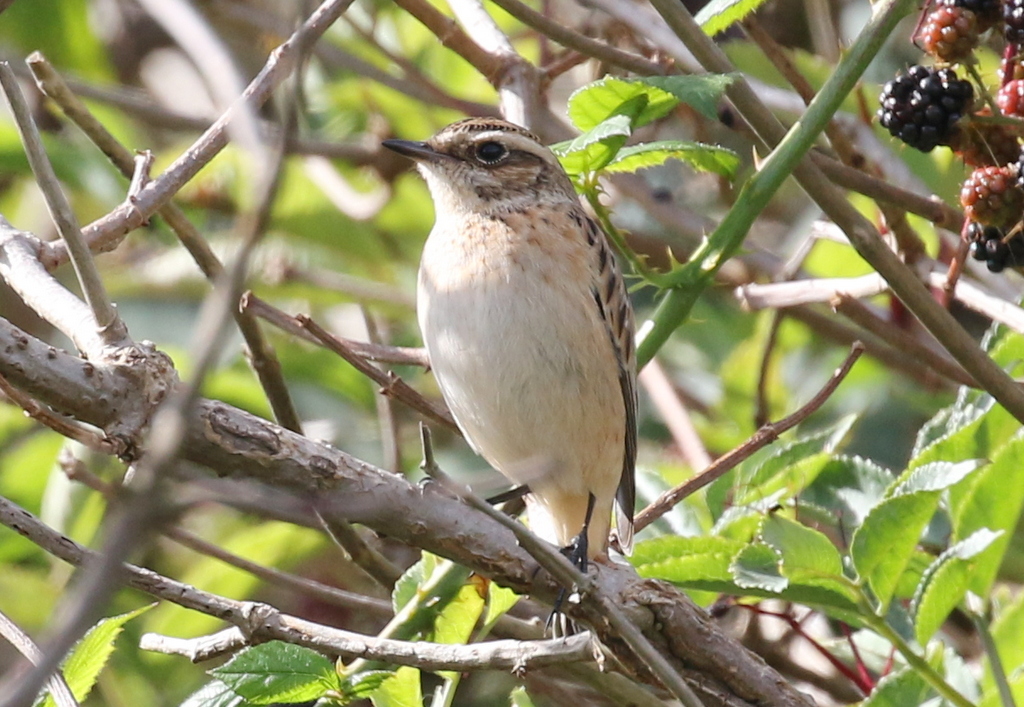
The trees just beyond held more Blue Tits and a Blackcap. Another Chiffchaff showed nicely in a birch tree, fluttering around in the leaves looking for insects. Another bird flew out and landed in the trees higher up the slope. A Redstart – another migrant breaking its journey here. It was quite hard to see, perched motionless in the leaves, until it flew again, darting across the path and disappearing round the back of some oaks the other side.
We walked round to the other side of the trees, but there was no further sign of the Redstart. However, we could see two crows feeding on the grassy slope of the dunes across the valley. They were noticeably grey around the nape and through the scope we could see they were Hooded Crow hybrids. One had more grey on it than the other, but neither had enough, in the right places to be a pure Hooded Crow. They intergrade fairly commonly with Carrion Crows, which was clearly the case with these two. Interesting birds to see anyway.
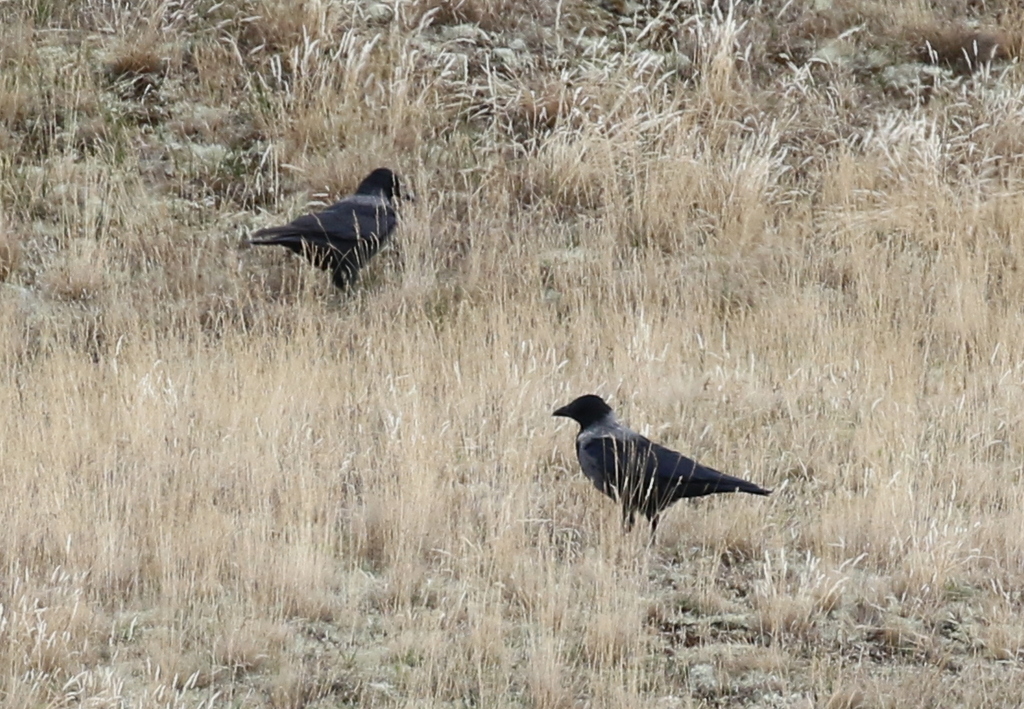
As we carried on south, there were several more warblers in the bushes – it was nice to see a few migrants here, despite the SW winds. A small flock of Meadow Pipits flew over calling, possibly on their way south.
There had been a Barred Warbler here yesterday, but when we got to the bushes where it was last seen we found several people looking, but no sign of the bird. Our second Lesser Whitethroat of the morning showed nicely on the outside of the hawthorns, eating blackberries, and while we were watching it a Sparrowhawk circled up over the houses at the top of the ridge. Another Chiffchaff was flitting about in the bushes too.
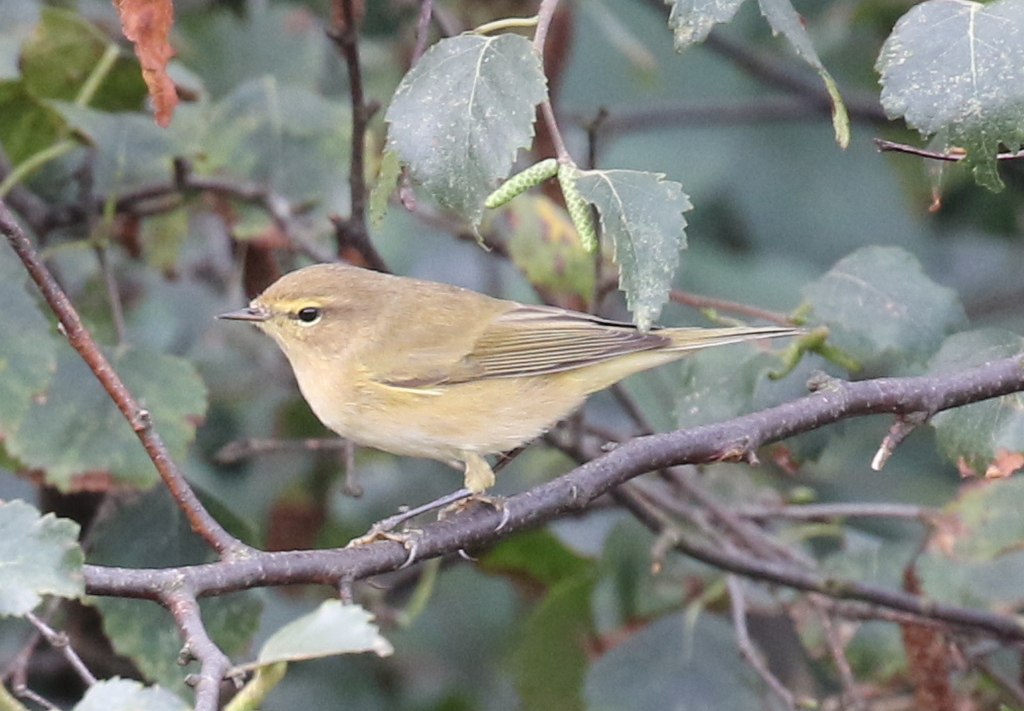
When we heard Swallows alarm calling, we looked up to see a flock flying over followed a few seconds later by a Hobby. It was a lovely clear view as it flew past at eye level, before climbing up and disappearing over the ridge. As it banked, we could see its orange-red trousers.
There were quite a few butterflies out in the sunshine this morning, mostly various whites. On the walk back, a Grayling basked on the brambles, angling itself to catch the sun and a Small Copper landed nearby, down in the grass.
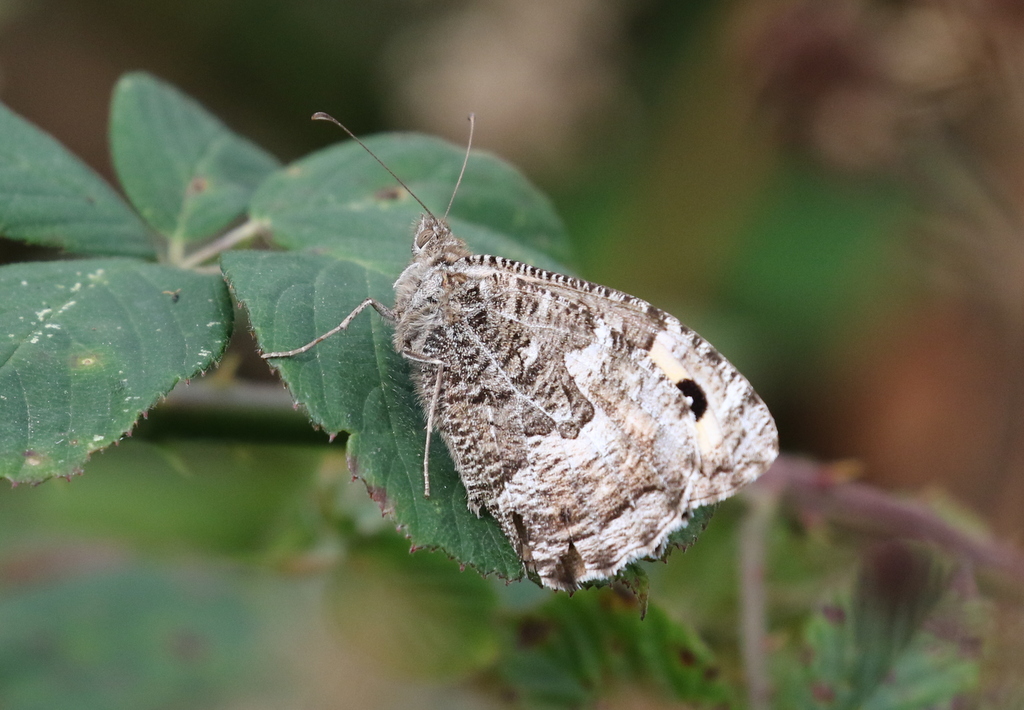
A Reeve’s Muntjac was feeding in the bushes half way up the slope. It stopped eating, stared at us for a minute or so, and then resumed its lunch. It seemed completely unconcerned by us passing close by.

As we got back to the road, it had clouded over and it felt like the wind had picked up a little, although we had been sheltered from it in the valley. We still had some time before lunch, so we decided to continue on into the North Dunes, to see if we could find a Wheatear. However, as we walked through the dunes, we were surprised to find almost no birds at all, not even a Meadow Pipit or a Linnet!
We got as far as the ‘east pond’, but it was cool and breezy here now and there were no signs of any Willow Emerald around the single small sallow. These damselflies are only very recent colonists in the UK and this can be a good place to see them. Up at the top of the dunes just beyond, we had a great panoramic view, but once again there was a surprising lack of birds. We decided to head back.
On our way back past the ‘east pond’, we at least had a brief view of two Willow Emerald damselflies around the sallow, although they quickly disappeared back in. There were several Common Darters which were more obliging, one or two Migrant Hawkers buzzing round, and a single Blue-tailed Damselfly down in the rushes in the edge of the water.
When we got back to the car park, it was time for lunch. As we ate, looking out to sea next to the boat sheds, a damselfly flew in and landed right at our feet. It was a Willow Emerald! It narrowly avoided being trodden on and flew up to bask on one of the sheds where we had a much better view of it than the two we had seen briefly earlier.
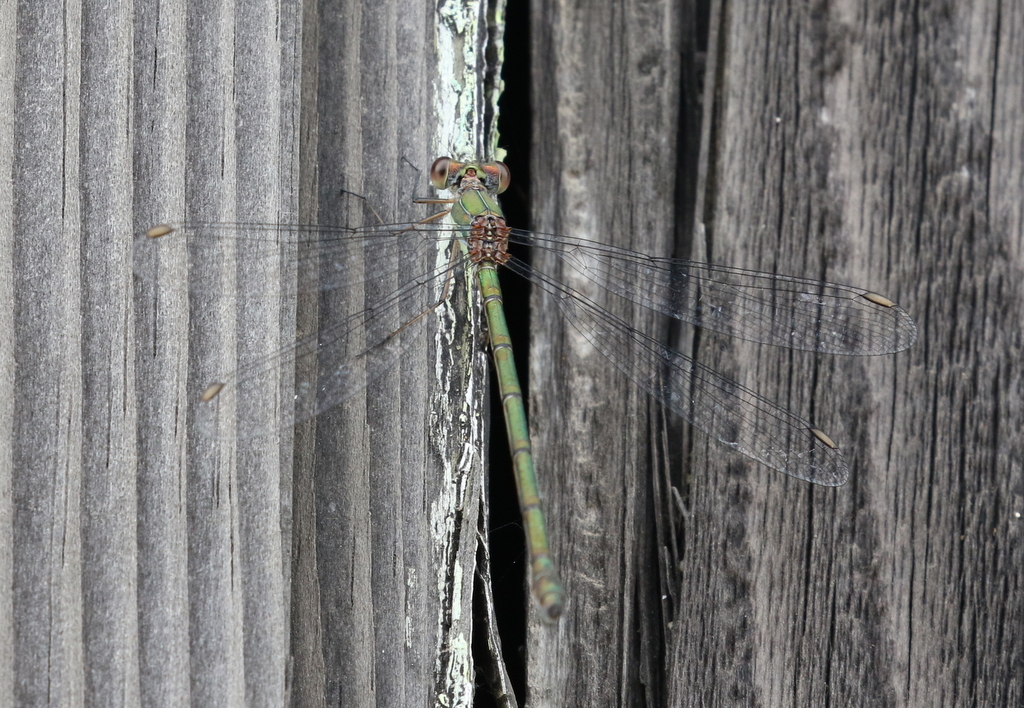
There were a few Mediterranean Gulls moving offshore, flying north along the coast. Two landed on the sea, an adult with bright red bill, black bandit mask and clean white wing tips, and a more subtle first winter.
After lunch, we headed inland to Potter Heigham to look for wildfowl and any waders. There were lots of Greylags out on the grazing meadows as we made our way in, accompanied by a pair of Egyptian Geese.
From up on the bank, we could scan the pools and we immediately spotted several Ruff out on the mud and a good number of Common Snipe around the edges of the reeds. Two Common Sandpipers were working their way round different parts of the shore. A flock of Golden Plover flew up and circled round calling and another group of smaller waders flew in and landed on the mud in the middle – nine Ringed Plover accompanied by a single Dunlin.

There were plenty of ducks here too, though the majority of the drakes are currently in their dull eclipse plumage, so they are not looking their best. Still, we could see a nice selection of Gadwall, Teal, Shoveler and Wigeon.
As we continued round on the bank, we could see a Marsh Harrier quartering the back of the grazing marshes in the distance, the other side of the channel. Their high pitched yelping calls alerted us to a flock of Pink-footed Geese high overhead. Flocks of these geese have been seen along the coast, returning from Iceland for the winter, in the last few days. These might well have just been returning here too, as this area is a regular roost site for Pink-footed Geese in the winter.
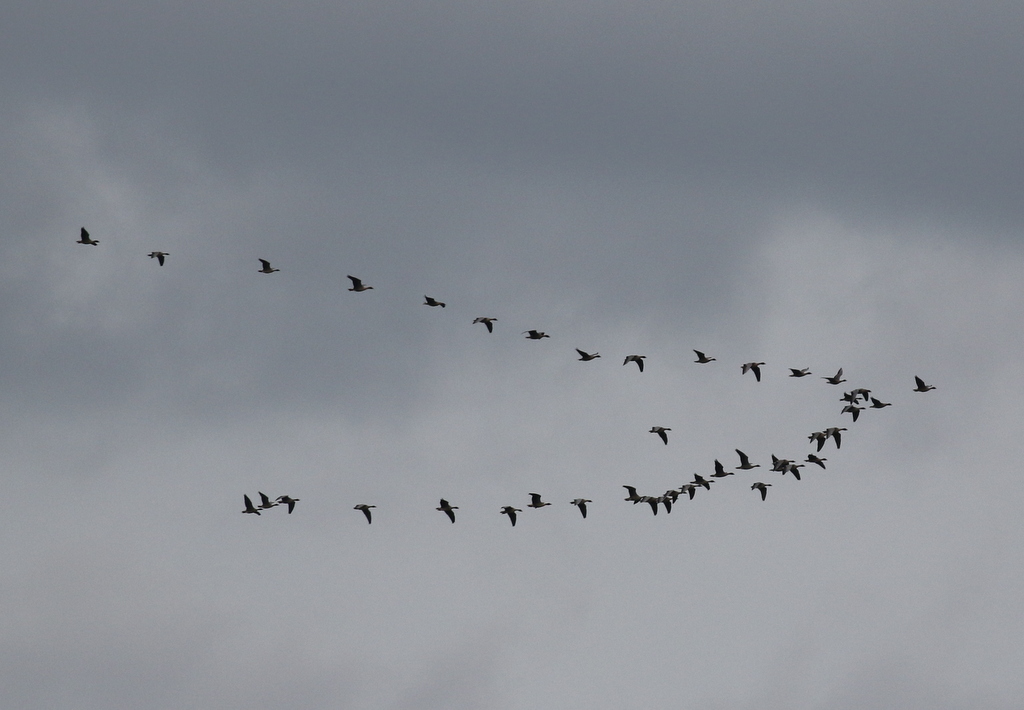
When we got to the river bank over the far side of the pools, we looked back to see a Hobby over hanging in the air over the grazing marshes the other side. It kept swooping down behind the trees before flying up again, presumably catching dragonflies low over the wet grass.
The pools over on this side have dried out a lot over the summer, but there are still some nice areas of water. When we heard a Greenshank calling, we looked across to find one asleep in some small tufts of grass on the edge of the mud. Three Green Sandpipers were feeding in one of the pools, along with a Ruff.
Otherwise, there were also more geese and ducks on this side, including a smart drake Wigeon back in breeding plumage already. A large group of Cormorants were sleeping on one of the islands.
The cloud had thickened progressively through the afternoon and the sky was now rather grey. We decided to walk back. On the way, we found two more Green Sandpipers on one of the other pools. A smart grey-winged male Marsh Harrier was quartering over the drier areas of the marshes.
With a long journey ahead of us, we decided to head for home. More again tomorrow…
















